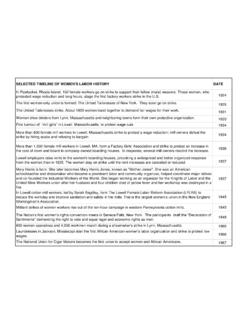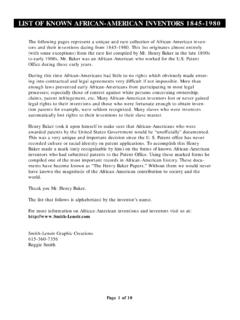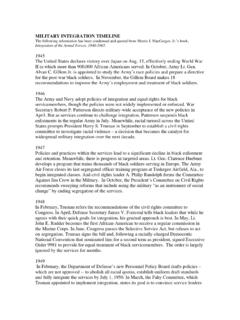Transcription of Historic Timeline for Agriculture and Natural Resources ...
1 Historic Timeline Date Item Description Research Memo 1785 Philadelphia Society for the Promotion of agricultural traveling Farmers Institutes, formation of state agricultural societies, Boards of Agriculture to support lectures, publications, and newspaper articles. Era of Farmers seeking new knowledge 1856 Vermont Congressman Justin S. Morrill intro resolution for agricultural schools modeled after West Point and Naval Era of Agricultural Societies, Grange, fairs Agricultural Societies 1857 Morrill reintroduces Ag School bill vetoed by President Buchanan in 1859 1859 Massachusetts sponsors first Institute for farmers by the State Board of Agriculture . New England agricultural societies proliferate Institutes 1859 State of Pennsylvania attempt at private farm college. Yale offers a few classes Failure of Private farm colleges 1860 US had 1300 Agricultural Societies with fairs, prizes, newspaper articles, journals Agricultural Societies 1862 President Lincoln signs Morrill Act to fund agricultural Land-Grant establish Land Grant colleges.
2 Birth of Cow land-grant lectures and seminars 1860s 1870s Land Grant colleges off to poor farmers distrust book farming, saw classes as irrelevant, lack of congressional support. Failure of Land Grant Colleges 1867 Grange era of modernization, industrialization, mechanization and the move to agribusiness Starts of Agribusiness in modern era 1869 University California starts Agriculture , mining, and mechanical arts programs 1876 Formation of Farmer s Alliance and start of Populism Birth of Populism 1887 Hatch Act gives Federal Funding for agricultural research in state land-grant colleges and saves the system Birth of Experiment Stations 1890 Morrill Act of 1890 authorizes expansion to more land-grant institutions fail without funding. Original Morrill Act colleges seek ways to reach farmers through Extension. 1890s Campus courses and traveling schools, lectures, and Farmer Institutes in cooperation with Agricultural Societies and Grange.
3 Farmer Institutes 1891 California farmer s institutes organized by UC College of Agriculture at request of State Grange. Subject determined by local community. Grange calls for separation of University and Agricultural Colleges. 1892 Through 1903 cotton boll weevil decimates Texas cotton industry 1894 Cornell University established an Extension Program at request of grape growers Birth of College Extension Programs 1896 Presidential election of William McKinley (Republican) marks shift to corporate America Corporate America 2 Date Item Description Research Memo 1897 UC creates a Department of University Extension in Agriculture headed by Wickson editor of Pacific Rural Press 1898 - 1914 Golden Age of American Agriculture .. Stable prices, no surpluses, and favorable trade at same time as US population shift moves to worries over stable food supply and shifts more emphasis to agribusiness ability to deliver large amount of food to cities.
4 1899 26 States draw 500,000 farmers to Farmer Institutes 1890s -1920s Gemeinschaft vs. Gessechaft. Industrial Gilded Age shift of political and economic energy from farm to urban and corporate. Today red vs. blue states. 1902 Numerous States Institute Boys and Girls Agricultural Clubs Youth Education 1903 CA state funds institutes, UC correspondence courses on AG topics 1903 Seaman Knapp, USDA employee in Louisiana, proposed a demonstration farm to teach farmers how to fight the weevil. Demo farm profits and Congress through the Bureau of Plant Industry funds program for Demonstration Farms. Farmer owned farms or cooperators succeed with university help and serve as regional models. Knapp model succeeds with new idea of single county agent supported partially with county support. Birth of Demonstration County Agent model 1900 More than 2,000 institutes held teaching, conducting research, and application results in Extension.
5 Railroads offer free educator travel feeling it would be good for future business 1900 California had 72,542 Farms 1904-1911 Railroad Demonstration Trains --- George Washington Carver pilots Moveable school. In US 71 trains ran in 26 States and reached 1 million men, women and children. Trains served as a transitional teaching method. Birth of Demonstration Education 1905 Extension Committee formed Birth of ECOP 1906 George Washington Carver Moveable School of Agriculture Model. 1907 USDA sponsors first Boys and Girls AG Clubs. Symbol of three leaf clover (head, heart, hands) Birth of 4-H Clubs 1908 President Theodore Commission on Country Life. Strong emotional element to concerns about saving superior rural lifestyle. Hope to promote local democracy and community-based leadership. Birth of Populism. Use Ag agents as a leavening agent to uplift local communities. Hopes for a Rural Country Life Movement 1908 Formation of Association of American Agricultural Colleges and Experiment Stations (AAACES) attempts to battle for funds.
6 Political battle over vocational or Extension funding. 1908 In California the Southern Pacific Railroad collaborated with UC and State Department of AG to sponsor agricultural demonstration trains. By 1912 made 461 stops, 7,430 miles with 176,287 crops, soils, insecticides, horticulture, viticulture, plant diseases, poultry, public health, and home economics. 3 Date Item Description Research Memo 1906-1914 Use of private and local, state, and federal funds to finance AG programs as a result of Knapp s cotton success. General Ed Fund ( Rockefeller endowed), local businesses, local taxes, equip businesses fund project. First County Agents Birth of County Agents 1909 Iowa, Kansas, Minnesota Departments of Extension and Superintendents or Directors at Colleges 1909 School Agricultural Clubs rural youth clubs under Southern Land grant colleges 1910 California had 88,197 Farms 1910 USDA appoints the first county home demonstration agent (Virginia).
7 Farmers Institutes offer education programs for home sanitation, kitchen equipment, house furnishings, home decoration, starch food preparation, breads, leftovers. Reading Courses 1911 62 trains carried 72 lecturers more than 35,000 miles and reached almost one million people 1911 4 -H name born Head, Heart, Hands, and Health 1911 William Jennings Bryant National Soil Fertility League goal of promoting a nationalized system of Extension based on Knapp Model and convinced AAACES to go with the county-based extension model. County-based extension model 1912 Missouri organized a Farm Bureau of local people to help with Extension work Birth of Farm Bureau idea 1912 California through UC encouraged formation of boy s and girl s agricultural clubs in rural areas. Worked with high school districts. By 1914 eighty-fours high schools had agricultural clubs 1913 Professor Clarke placed in charge of new Division of Agricultural Extension in School of Ag at UC Berkeley 1913 First California Farm Advisor hired --- Humbolt Dairy farms UC, Humbolt Board of Supervisors, Ferndale Dairymen s Association, and the County Chamber of Commerce.
8 Quickly followed with Advisors in San Diego, San Joaquin, and Yolo Counties. 1913 Humbolt County Farm Bureau organized first in CA First CA Farm Bureau 1914 Congress passes Smith-Lever Act to fund nationwide Extension work. Funds for cooperative administration of agricultural education by USDA and state land-grant colleges with mission of increasing productivity and improvement of rural life. More than matched local funding for Extension programs like --- 4H, home economics, community development, farm. $600,000 year one and next seven years at $500,000. The States Relations Committee founded. Insures long-term funding, county-based agents, demonstration farms Insures long-term funding, county-based agents, demonstration farms 4 Date Item Description Research Memo 1914 Crocheron became Director of the California Agricultural Extension and served until 1948. Wrote the publications that defined the role of the Farm Advisor and the function of the county farm bureau and thus laid the foundations of Extension in California.
9 He insisted that county-based agents be appointed, supervised, and paid by the university making their status as educations beyond political pressures. Their expenses were to be paid by the county so they would be close to local needs. 1914 UC Circular 118 (June 1914) defines a Farm Bureau as a local organization of farmers and ranchers who combine to promote Agriculture through cooperative study of farm conditions. Each Farm Bureau (at least 20% of county farmers) consisted of up to a dozen farm centers located in local rural schoolhouses for meetings. 1915 Extension Committee on Organization and Policy (ECOP) with 13 members as vehicle by which the Cooperative Extension Service system achieves a sense of common mission and purpose. Name changed to States Relations Service. 1916 Typical CA Farm Advisor --- 31 years old, each week had 3 meetings with an average attendance of about 100, visited 16 farms, and traveled 277 miles.
10 Used Model T Fords or motorcycles. Counties and the University made 3 year agreements and were funded by counties, state legislature, and the USDA. 1916 Farm Advisor Role: provide useful information, but not direct action. Investigate farm problems and demonstrate and advise solutions. County residents had to request an advisor and the Board of Supervisors would appropriate $2000 for office and travel expenses. 20 % of county farmers had to organize work with the advisor and members paid $ annual dues. The University paid the salary of the Advisor. Era of Institutes begins to end 1916 California employed several itinerant home demonstration agents for lectures and demonstrations on canning jelly making, nutrition, home economy and management. By 1917 over 595 women in 16 clubs were solving home problems in regular programs 1917 Cooperative Extension had a strong base of operation in every state 1917 Food Production Act provided congressional funding to expand Cooperative Extension with incentives for farmers to increase production for the last sack of flour that would help win WWI.









